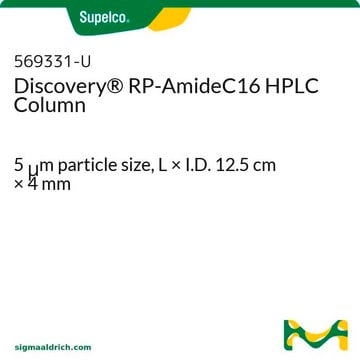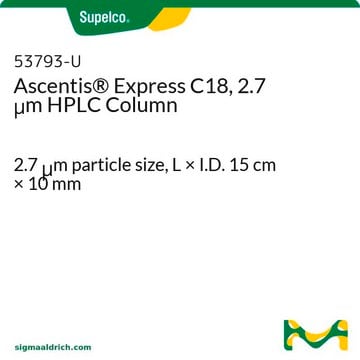Products may be shipped at a different temperature than the recommended long-term storage temperature. If the product quality is sensitive to short-term exposure to conditions other than the recommended long-term storage, it will be shipped on wet or dry-ice. If the product quality is NOT affected by short-term exposure to conditions other than the recommended long-term storage, it will be shipped at ambient temperature. As shipping routes are configured for minimum transit times, shipping at ambient temperature helps control shipping costs for our customers. For more information, please refer to the Storage and Transport Conditions document: https://www.sigmaaldrich.com/deepweb/assets/sigmaaldrich/marketing/global/documents/316/622/storage-transport-conditions-mk.pdf
53829-U
Ascentis® Express 90 Å C18 (2.7 μm) HPLC Columns
L × I.D. 15 cm × 4.6 mm, HPLC Column
Synonym(s):
Core-shell (SPP) Fused Core C18 HPLC column
About This Item
superficially porous particle
Recommended Products
Product Name
Ascentis® Express C18, 2.7 μm HPLC Column, 2.7 μm particle size, L × I.D. 15 cm × 4.6 mm
material
stainless steel column
Quality Level
Agency
suitable for USP L1
product line
Ascentis®
feature
endcapped
manufacturer/tradename
Ascentis®
packaging
1 ea of
parameter
60 °C temp. range
600 bar max. pressure (9000 psi)
technique(s)
HPLC: suitable
LC/MS: suitable
UHPLC-MS: suitable
UHPLC: suitable
L × I.D.
15 cm × 4.6 mm
surface area
135 m2/g
impurities
<5 ppm metals
matrix
Fused-Core particle platform
superficially porous particle
matrix active group
C18 (octadecyl) phase
particle size
2.7 μm
pore size
90 Å
operating pH
2-9
application(s)
food and beverages
separation technique
reversed phase
Looking for similar products? Visit Product Comparison Guide
Related Categories
General description
Visit the Ascentis Express home page for more information on this new column technology.
Application
Legal Information
Not finding the right product?
Try our Product Selector Tool.
Application
recommended
related product
Choose from one of the most recent versions:
Certificates of Analysis (COA)
Don't see the Right Version?
If you require a particular version, you can look up a specific certificate by the Lot or Batch number.
Already Own This Product?
Find documentation for the products that you have recently purchased in the Document Library.
Customers Also Viewed
Articles
USP methods continuously revised for modernization and improved results in drug testing.
Optimize HPLC method for ginsenoside separation using a mixture, applying it to American Ginseng root, with conditions and chromatograms shown.
Derivatization of Aliphatic Amines - Results from the Supelco Ascentis Express column show higher peak resolution, and improved peak shapes than typical chromatograms.
Protocols
Lopinavir assay setup saves time and improves efficiency with shorter columns, meeting European pharmacopoeia guidelines.
Investigate bile acid roles in gut hormone profiles and glycemic control, vital for clinical labs exploring potential mechanisms.
-methylcarbamate 10 μg/mL; Diuron; Propham; Siduron; Methiocarb, analytical standard; Linuron 10 μg/mL; Swep 10 μg/mL; Chlorpropham 10 μg/mL; Barban; Neburon
Related Content
Ibuprofen and impurity separation using Ascentis Express 90Å C18 column with excellent peak shape and low quantification limits.
Bile Acids (BA) are synthesized in the liver and play important roles in cholesterol homeostasis, absorption of vitamins and lipids, and various key metabolic processes.
Accurately detect and quantify trace nitrosamines (NDMA, NDEA, NEIPA, NDIPA, NDBA, etc.) in pharmaceutical drugs using our complete product portfolio and application guides for LC-MS and GC-MS. Order high-quality reference standards, columns, filters & more.
Chromatograms
application for HPLCapplication for HPLCapplication for HPLCapplication for HPLCShow More-
How is shipping temperature determined? And how is it related to the product storage temperature?
1 answer-
Helpful?
-
-
How can I determine the shelf life / expiration / retest date of this product?
1 answer-
If this product has an expiration or retest date, it will be shown on the Certificate of Analysis (COA, CofA). If there is no retest or expiration date listed on the product's COA, we do not have suitable stability data to determine a shelf life. For these products, the only date on the COA will be the release date; a retest, expiration, or use-by-date will not be displayed.
For all products, we recommend handling per defined conditions as printed in our product literature and website product descriptions. We recommend that products should be routinely inspected by customers to ensure they perform as expected.
For products without retest or expiration dates, our standard warranty of 1 year from the date of shipment is applicable.
For more information, please refer to the Product Dating Information document: https://www.sigmaaldrich.com/deepweb/assets/sigmaaldrich/marketing/global/documents/449/386/product-dating-information-mk.pdfHelpful?
-
-
can this column be used at higher pH (pH 9)?
1 answer-
As noted in the 'PROPERTIES' section, this column has an operating pH of 2 - 9.
Helpful?
-
-
What are the recommended long-term storage conditions for the Ascentis® Express C18, 2.7 μm HPLC Column?
1 answer-
For long-term storage of silica-based, reversed-phase columns like the Ascentis® Express C18, 2.7 μm HPLC Column, it is recommended to store them in 100% acetonitrile. For shorter periods of storage (up to 3 or 4 days), it is generally safe to store the column in most common mobile phases. However, when using buffers, it is advised to protect both the column and the HPLC equipment by flushing the column with the mobile phase that does not contain the buffer. This can be accomplished by flushing the column with a mixture of the mobile phase without the buffer (e.g., when using 60/40 ACN/buffer, flush the column with 60/40 ACN/H2O). This flushing step helps eliminate any risk of corrosion from salts and ensures quick re-equilibration of the column with the original mobile phase. Additionally, before storing the column, it is important to tightly seal the end-fittings with the provided end plugs to prevent the packing material from drying out.
Helpful?
-
-
What is the part number for Phenomenex Kinetex C18 column with dimensions of 150mm (15cm) x 4.6mm ID x 2.6μm particle size?
1 answer-
Unfortunately, we do not provide the Kinetex C18 column from Phenomenex. However, we offer our own alternative with similar characteristics, the Ascentis Express C18 column with a particle size of 2.7μm. The specific part number for this column is 538229-U. Please note that the minimal difference of 1μm in particle size should not significantly impact its performance.
Helpful?
-
-
What flow rate should I use with Ascentis® Express HPLC Columns?
1 answer-
Based on the minimum in the van Deemter curves, higher flows than 5um particle columns are required in order to maximize Ascentis Express column efficiency. The suggested starting point for flow rate for Ascentis Express columns: 1.6 mL/min for 4.6 mm ID; 0.8 mL/min for 3.0 mm ID; and 0.4mL/min for 2.1 mm ID.
Helpful?
-
-
What is the Department of Transportation shipping information for this product?
1 answer-
Transportation information can be found in Section 14 of the product's (M)SDS.To access the shipping information for this material, use the link on the product detail page for the product.
Helpful?
-
-
Can I use Ascentis Express on any type of HPLC system?
1 answer-
Ascentis Express HPLC columns are capable of use on standard HPLC systems as well as UHPLC systems. Columns are packed in high pressure hardware capable of withstanding the pressures used in UHPLC systems.
Helpful?
-
-
What is the carbon load for Ascentis® Express C18 HPLC Columns?
1 answer-
Carbon load which is commonly referred to as %Carbon is misleading and not meaningful for Ascentis® Express. Since Fused-Core™ particle is unique in the sense that it has a solid core and porous shell, the %Carbon number can not be compared to traditional porous particles. The carbon coverage for Ascentis® Express C18 is 3.5 micromoles/meter-squared
Helpful?
-
-
How can I measure my instrument bandwidth (IBW) and determine what Ascentis® Express HPLC Columns can be used with minimal efficiency loss created by too much internal instrument volume?
1 answer-
The Guide to Dispersion Measurement has simple instructions on how to measure IBW and can be found at sigma-aldrich.com/express.
Helpful?
-
Active Filters
Our team of scientists has experience in all areas of research including Life Science, Material Science, Chemical Synthesis, Chromatography, Analytical and many others.
Contact Technical Service










